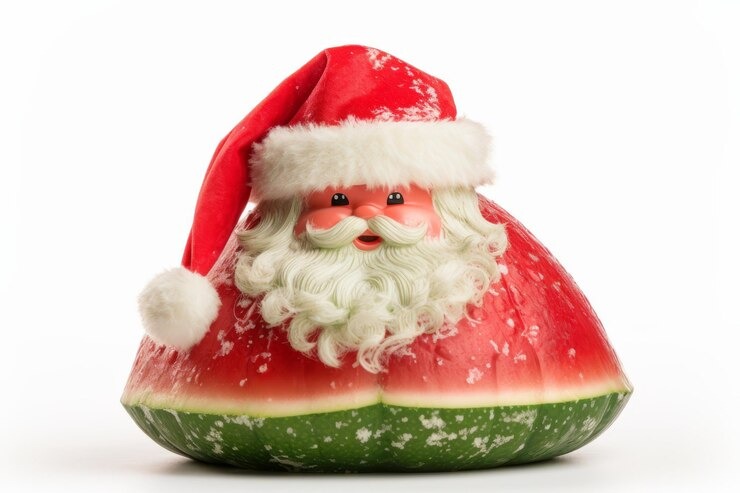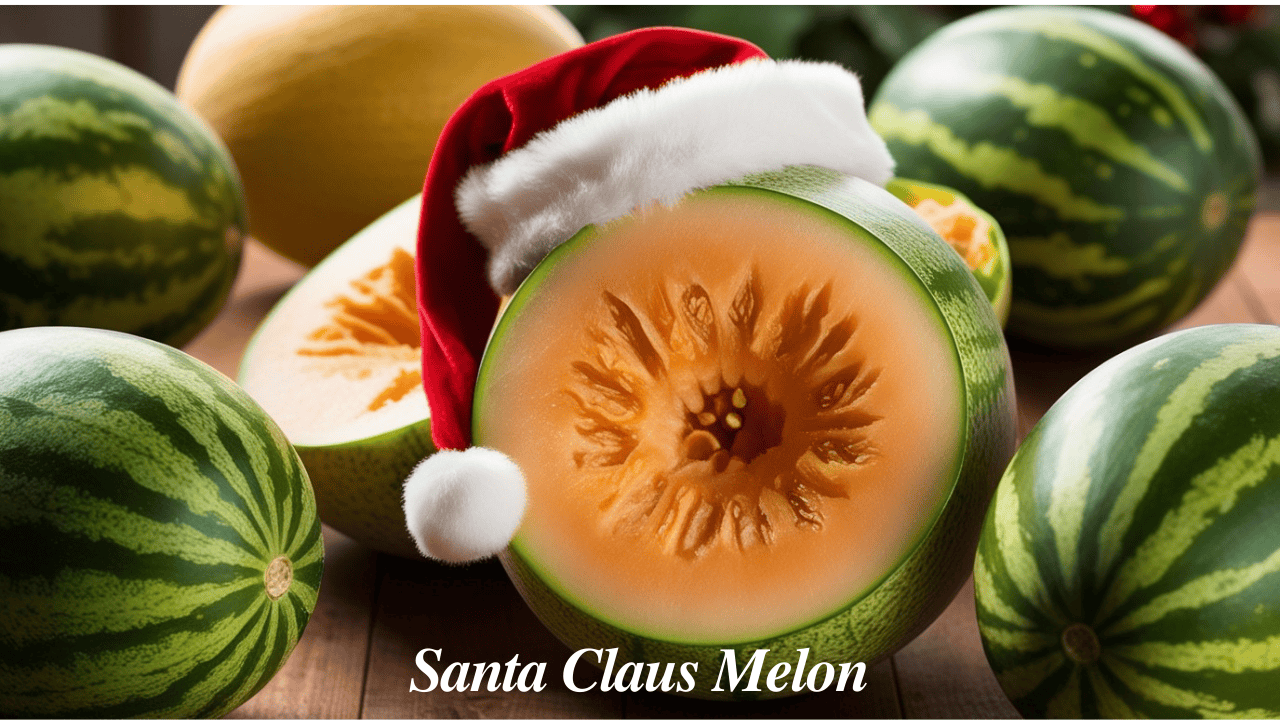The Santa Claus melon, also known as Piel de Sapo or Christmas melon, is a delightful fruit that surprises with its sweet, honey-like flavor. Perfectly named for its extended shelf life and festive appearance, this melon has slowly gained global popularity. While many people are familiar with watermelons and cantaloupes, the Santa Claus melon holds a unique place among summer fruits, blending taste with health benefits.
In this article, we’ll explore everything about the Santa Claus melon – from how it tastes to the best ways to enjoy it, along with tips on storage, nutritional benefits, and more. If you’re looking to introduce new, delicious fruits to your diet, this exotic melon is worth discovering.
What is a Santa Claus Melon?

Santa Claus melon, scientifically named Cucumis melo, is a type of winter melon known for its thick green-striped rind and pale yellow to greenish flesh. Its name stems from its ability to last for several weeks, often staying fresh until Christmas, hence the festive reference. Originating from Spain, the melon has now become a favorite in many parts of Europe, North America, and South America.
The skin is tough and bumpy, resembling a toad (which explains the Spanish nickname Piel de Sapo, meaning “toad’s skin”). Despite its humble exterior, the inside reveals a succulent and sweet flesh, similar to that of honeydew melons.
Taste and Texture of Santa Claus Melon
The Santa Claus melon offers a mild, sweet flavor, with hints of honey and pear. Unlike cantaloupes, its taste is more subtle, which makes it perfect for mixing into fruit salads or smoothies. The flesh is firm yet juicy, creating a satisfying bite with every spoonful. This melon is less aromatic than some other varieties, but its flavor grows on you – making it perfect for those who prefer a less overpowering fruit.
Santa Claus Melon Nutritional Profile
This delicious melon is not just about taste; it also packs a lot of nutrients in every bite. Santa Claus melons are:
- Low in calories: A great option for weight-conscious eaters, as 100 grams contain only around 30 calories.
- High in water content: Hydrates the body and keeps you feeling refreshed.
- Rich in vitamins: Contains Vitamin C and small amounts of Vitamin A, which support the immune system and eye health.
- A good source of potassium: Helps regulate blood pressure and supports heart function.
- Dietary fiber: Aids digestion and promotes gut health.
How to Eat Santa Claus Melon
Eating a Santa Claus melon is simple and enjoyable. Follow these steps to get the most out of this refreshing fruit:
- Cut the melon in half: Use a sharp knife to slice it lengthwise.
- Remove the seeds: Scoop out the seeds using a spoon.
- Slice into wedges: You can eat the flesh right off the rind or peel the skin off first.
- Chill before serving: For a refreshing treat, refrigerate the melon for at least an hour.
Creative Ways to Enjoy Santa Claus Melon
This melon isn’t just for slicing and snacking. Here are some fun ways to incorporate it into your meals:
- Fruit Salad: Mix cubes of Santa Cllaus melon with berries, kiwi, and mint for a colorful summer salad.
- Smoothies: Blend with yogurt, honey, and lime for a refreshing drink.
- Prosciutto & Melon: Pair with salty prosciutto for an appetizer that’s both sweet and savory.
- Frozen Treats: Puree the melon and freeze it to make sorbet or popsicles.
How to Store Santa Claus Melon
The Santa Claus melon has a long shelf life, making it ideal for stocking up during the summer or early winter months. Follow these tips for proper storage:
- Uncut Melons: Store in a cool, dry place. They can last for up to a month at room temperature.
- Refrigerate after cutting: Place cut pieces in an airtight container and store them in the refrigerator for up to five days.
- Avoid freezing: Freezing affects the texture, making it mushy when thawed.
Santa Claus Melon vs. Honeydew: Key Differences
While the Santa Claus melon and honeydew melon may seem similar, they have a few distinctions:
| Feature | Santa Claus Melon | Honeydew Melon |
|---|---|---|
| Skin Texture | Rough, green-striped | Smooth, pale green |
| Flavor | Mild, with hints of honey | Sweet, with stronger flavor |
| Shelf Life | Longer (up to a month) | Shorter (about 1-2 weeks) |
| Peak Season | Summer to early winter | Summer |
Health Benefits of Santa Claus Melon
- Boosts Hydration: With over 90% water content, it helps keep the body hydrated during hot weather.
- Supports Immune System: The Vitamin C content boosts immunity and promotes collagen production.
- Improves Digestion: The fiber helps prevent constipation and keeps your digestive system healthy.
- Promotes Heart Health: Potassium supports cardiovascular health by regulating blood pressure.
- Aids Weight Management: Its low-calorie content makes it a guilt-free snack for those trying to lose weight.
Where to Buy Santa Claus Melon
Santa Claus melons are typically available during the warmer months in specialty grocery stores, farmer’s markets, and some supermarkets. During peak season, you may find them in abundance at stores with a good variety of fruits.
Look for melons that feel heavy for their size and have a firm, unblemished skin. A slight softness at the stem end indicates ripeness.
Santa Claus Melon: A Global Favorite
Though the fruit originates from Spain, it is now widely grown in places like California, Brazil, and Central America. In Spain, the melon has become a symbol of Christmas festivities, frequently gifted or shared during the holiday season.
In the United States, the fruit is gaining popularity among health-conscious consumers due to its nutritional value and versatility.
FAQs
How do you know when a Santa Claus melon is ripe?
Look for a slight give at the stem end, and the melon should feel heavy for its size.
Can Santa Cllaus melon help with weight loss?
Yes, its low-calorie content makes it an excellent option for those looking to manage their weight.
Is the Santa Claus melon available year-round?
While it has a long shelf life, the melon is primarily available in the summer and early winter months.
What are some common dishes that use Santa Claus melon?
You can enjoy it in fruit salads, smoothies, or paired with prosciutto for a delicious appetizer.
How long can you store a cut Santa Cllaus melon?
Cut pieces should be stored in an airtight container in the fridge and consumed within five days.
What makes Santa Cllaus melon different from cantaloupe?
The Santa Clus melon has a milder flavor and a firmer texture compared to cantaloupe.
Conclusion
The Santa Clauss melon is an underrated gem among fruits, offering a unique blend of sweetness and versatility. Its long shelf life and refreshing taste make it ideal for both warm summer days and festive winter occasions. With a range of health benefits – from hydration to heart health – this fruit deserves a place on your grocery list.











